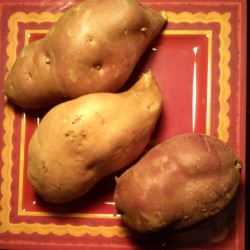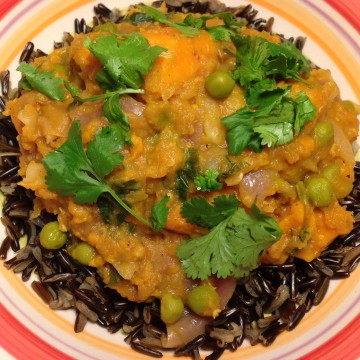The sweet potato is the 7th most popular crop on Earth, and no wonder! Delicious, versatile, healthy and filling; sweet potatoes have been a staple of many cultures for millennia. Scientists have even tracked the spread of the sweet potato and observed that the vegetable was transmitted from the Andes to Polynesia about 400 years before Columbus came to the Americas. There is other evidence to the theory that the Polynesians and the Native South Americans had contact with one another, such as the Polynesian DNA found in skulls from Brazil.
After being taken to Spain in about 1500, the sweet potato was widely cultivated and spread throughout Europe all the way to Japan, where it is the 3rd most important crop. The word potato actually comes from the sweet potato–the Spanish Royal Academy says the Spanish word for potato is “patata,” conflating Taino “batata” and the Quecha’s “papa.” The “sweet” of the sweet potato was added later to differentiate between that and the Irish or white potato.
The sweet potato grows well in the tropics and subtropics, thriving in a hot and moist climate. The sweet potato, or Ipomoea batatas, is part of the morning glory family, and thus is not a Yam, which is an entirely different plant species altogether.
Why is this tuber so popular? One sweet potato supplies over 100% of the RDA for Vitamin A, has 0g fat, 0 mg cholesterol, 20 mg Vitamin C, 38g Calcium, and 11,552 mcg Carotenoids. Not to mention, sweet potatoes also have great fiber content, in the skin of the potato as well as the inside, which helps manage weight. According to The Harvard School of Public Health, most people aren’t getting the 20-35g of fiber needed per day, and one cup of sweet potatoes has 6.6 grams of fiber, which really adds up! The sweet potato also produces “more edible energy per hectare per day than wheat, rice, or cassava,” which is cool on a global scale–we could (can) feed the entire human population with plants!
In Ethiopia, where it is estimated over half of all children die before the age of five, and 42% of children under five are underweight, there is a sustainable food project having much success with crops like the sweet potato.
Ethiopian Wat with Wild Rice ( inspired by this recipe)
Berbere Spice Mix (you only need 1tbsp of this in the recipe, or to taste):
4 1/2 tsp red chili flakes
1 tsp fenugreek powder
1tsp turmeric
1 tsp sea salt
3tbsp paprika
1/2 tsp cinnamon
1/2 tsp allspice
1 tsp ground coriander
1/4 tsp ground clove
1 tsp black pepper
2 Sweet Potatoes
1 Red Onion
3 Cloves Garlic
1 Tbsp grated Ginger
1c Dry Red Lentils
1 Tbsp Berbere spice Mix
1/4 Cabbage
1 heaping cup chopped Kale
1c Peas
1 Tomato
1 Liter low sodium Vegetable Broth
Salt, to taste (I used 2 pinches)
Juice of 1- 1 and 1/3 Lemon
Fresh Cilantro
1. Chop onion and sautee in water in large sauce pan until the onion becomes translucent. Add more water when needed.
2. Add ginger and garlic, sautee for about another minute or so before adding: berbere spice, sweet potatoes, tomato, cabbage, peas (sautee for a minute or so), salt, veggie stock, and lentils.
3. Bring to boil, and then simmer with the lid on for 20-25 minutes, or until the potatoes and lentils are soft.
4. Add lemon juice, cilantro, and kale and take off heat. Let cool, and serve over wild rice (or eat by itself, it’s good!) with cilantro and some more lemon juice squeezed on top if you desire. This is traditionally served with Injera Flatbread.
Also by Jessica: 10 Tips for New Vegans
Health Benefits of Miso Soup, plus Recipe!
__
Photo: Jessica Ferguson






